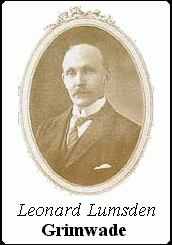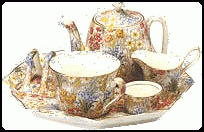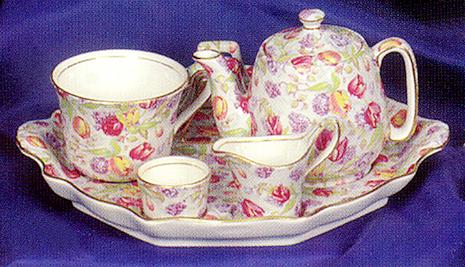
(click on the above logo to go to the Official Royal Winton Web Site)
Here is yet another installment
of many guides that we, Replacements Ltd, will be posting to provide
some interesting information on several manufacturer's of some
the world's most collectible porcelain items
This one will be about Chintzware - the beloved china with
the "all over" floral designs
With its cheery flowers, rich colors, and variety of designs -
one can't help but smile when you see it!
The word "chintz" is derived from the Indian word "chint,"
meaning broad, brightly printed fabric
Floral chintz patterns date back to the early 17th century
English, Spanish, Portuguese, and Italian adventurers were busy
exploring and searching for the new world
Many visitors who explored the East returned with treasures from
the lands they had visited
Several explorers brought with them fantastically decorated fabrics
from India
Generally, these fabrics were thickly woven and featured brightly
colored floral and bird designs
The intricately decorated fabrics became popular throughout the
European continent
At the same time, a renaissance of sorts was occurring in the
pottery and porcelain industry
Pottery producers were experimenting with new glazes and decorating
techniques
Josiah Wedgwood, Josiah Spode, and John Doulton each experimented
with new clays, glazes, and decorating techniques
The pottery industry witnessed a number of advances during this
period thanks to the hard work of these entrepreneurs
Several pottery manufacturers wanted to replicate the brightly
colored Indian designs found on chintz fabric
And by the 1820’s there were several companies in Staffordshire,
England that were producing chintz decorated porcelain - but these
patterns were less intricate with looser designs, larger printed
flowers, and exotic birds
This very early “chintz” was regarded as everyday china
and not held with the same high standard of finer china of the
time
During this early period, a suitable technique for transferring
intricate motifs had not been developed
China manufacturers found it equally difficult to reproduce colors
that were true to the flowers they represented
It was not until the 1920’s that the designs switched gears
and became more intricate with tighter florals and richer colors
Grimwades Ltd, now known as Royal Winton, is a name that has
been long associated with fantastically designed chintz patterns
This revelation in chintz production started with two brothers,
Sydney and Leonard Grimwade
They were instrumental in the development of manufacturing processes
that allowed for the production of chintz china
They acquired the Winton Porcelain factory and renamed it Grimwades
Ltd
Before opening his china factory, Leonard Grimwade worked as a
lithographer, or print maker
Two inventions of Leonard Grimwade's, duplex lithographic transferring,
and the Climax kiln, would forever change how chintz was produced,
and also had a significant impact on the dinnerware industry as
a whole
Duplex lithographs were designs printed on thin tissues, with
detachable backs
Pattern prints were applied to the paper, and then transferred
to the ceramic piece by removing the detachable backing
This new process allowed chintz patterns to be produced quickly
and efficiently
To complement the pattern application process, Leonard created
the Climax kiln
Unlike traditional kilns that had to be loaded, heated, cooled,
then unloaded, the Climax Kiln operated continuously, and ceramics
were moved in and out with carts on wheels
Ceramics, and in particular chintz patterns, could now be mass-produced.
Leonard's inventions assured long-term success for his company
The first chintz
pattern they released was entitled Marguerite
The design for the Marguerite pattern came from a pillow that
Leonard Grimwade’s wife was stitching
Mrs. Grimwade’s pillow was decorated with a replication of
an Indian chintz fabric
Marguerite became an instant sales success
However, today - it is one of the least desired chintz patterns
Two years following the
release of this pattern, Grimwades Ltd. changed their name to
Royal Winton
And over the course of 50 years they produced over 80 different
chintz patterns
Some of these more popular patterns were Summertime, Old Cottage
Chintz, Welbeck and Royalty
There was a time after the WWII, that they came up with 15 new
patterns in attempt revive the factory after the war
Some of these were Sweet Pea, Stratford, Nantwich, Julia and Beeston
In order to come up with new and different patterns, Royal Winton
started a trend of reversing the background color on some of their
more popular patterns to create a different pattern with a fresh
look
Some examples were the yellow background of Welbeck was changed
to black to create Hazel and it was also changed to white to create
Spring and the golden-yellow background of Royalty was changed
to black to make Majestic
Following Royal Winton’s success, many other china manufacturers
began reproducing the elegantly detailed chintz fabric designs
James Kent pottery released several chintz patterns; including
Apple Blossom, DuBarry, Hydrangea and Rosalynde
Another popular chintz manufacturer was Elijah Cotton of Lorn
Nelson
They actually were known for making plain white ware for commercial
or hospital use
They ventured into chintz and today their patterns are some of
the most hard to find and can be some of the most expensive due
to the rarity
Some of their more popular ones were Black Beauty, Rose Time,
Heather and Green Tulip
Shelley of England also was well known for their bone china chintz
designs, however they did create some earthenware chintz designs
as well
Their chintz is also very desirable and can be very hard to find
- some of these are Rock Garden, Melody, Daisy and Maytime
Other companies that were very successful with regular non-chintz
patterns also made some chintz patterns that have proved to be
very popular over the years
Johnson Brothers released Summer Chintz and Rose Chintz - both
are still active and thriving
Minton’s Haddon Hall has also been an active pattern for
over 50 years
Royal Albert’s, Old Country Roses, which is said to be the
most popular china pattern in the world!, even has several chintz
versions that were recently introduced in the past decade
The early sixties brought higher labor costs and lower demand
for tableware, particularly chintz patterns, which many consumers
began to perceive as being "dated"
Even with transfer processes, producing chintz was still a relatively
labor-intensive process
Royal Winton, acquired by Henry Pottery Ltd. in a corporate buyout,
discontinued all of the previously produced chintz patterns in
favor of giftware
As the years wore on, demand for chintz pieces in the antique
market showed that consumers were still enamored with the simple
beauty and elegance of chintz dinnerware
Customers, the American market in particular, wanted chintz, and
they wanted it in quantity!
In 1993, Spencer Hammer and Associates arranged a takeover of
Royal Winton
The firm reinstated the Grimwades Limited name, and continued
the tradition of trading as Royal Winton
The company's board decided the first course of action would be
to resurrect the once proud chintz lines
Many "old" patterns were produced once more
Chintz remains immensely collectible throughout the world
In addition to Royal Winton, Kent along with several other china
companies have re-released many of their original chintz patterns
as well as some new ones
These newer released patterns give collectors, both new and old
alike, a chance to get newer and less delicate items at great
prices to enjoy and use everyday - most of them are even dishwasher
safe!
Obtaining new chintz allows a collector to simply just display
their prized antique pieces while enjoying using the newer patterns
without the fear of damaging an extremely rare piece!
You can find a fantastic array of both Older-Vintage and New Chintz
Happy Chintz-ing!

The Royal Winton brand has always been synonymous with quality and design and has roots in Stoke-on-Trent, England that go back over one hundred years

Originally known as Grimwade Brothers it
was founded by Leonard Lumsden Grimwade
Leonard had shown a natural talent for modelling pottery and it
was in this field that his infant business began, in 1885
He was soon joined in the business by his older brother, Sidney
Richard, another potter
By 1890 new showrooms had been purchased in Stoke-on-Trent and
London
It is a measure of the company's success that by 1906 Grimwades
Limited was operating from four factories in the potteries
Leonard experimented with new methods of manufacture and he developed
the enamel climax Rotary Kiln, Duplex Lithographic transfers and
other ground breaking techniques
In 1913 King George V and Queen Mary visited the potteries and
the brothers issued a catalogue to commemorate the event
The Queen purchased a Winton Teaset and was delighted to be presented
with a gift of a Mecca Foot Warmer (an oval ceramic hot water
bottle)
 --In
1928, 'Marguerite' the first Royal Winton Chintz pattern, was
launched and was an immediate success
--In
1928, 'Marguerite' the first Royal Winton Chintz pattern, was
launched and was an immediate success
These tightly grouped, highly detailed and vibrant all over floral
patterns were to become a milestone in the company's reputation
for versatility and beauty
Following an advertisement in the 'Potteries
gazette' in 1929, Royal Winton became the established trade name
for Grimwades Limited and has remained so through to the present
day
Leonard Grimwade died in 1931, but his legacy survived and the
company went from strength to strength under the leadership of
James Plant
Over succeeding decades Royal Winton introduced more than 60 Chintz
patterns and became the leading producer of this style of decoration,
exporting to most Commonwealth countries and the USA
Discontinued in the early 1960's due to the high production
costs associated with this style of decoration, Royal Winton Chintz
has become highly desirable in the antique market today
Collectors Clubs have been established world-wide and many reference
books have been published, with Christie's of London running auctions
dedicated to Chintz pottery
In 1995 the company was purchased by its current owners who reverted
back to the original company name of Grimwades Limited trading
as Royal Winton
Chairman Ian Davis commented "It soon became apparent that
we had acquired a company with a unique heritage"
Since acquisition, some of the more popular Chintz patterns
have been reintroduced on a range of giftware, tableware and Limited
Edition pieces
Hand crafted in the 'Potteries', Staffordshire England, Royal
Winton Chintz undergoes eighteen separate production processes
and is fired four times
Old lithographing techniques have been resurrected to achieve
the all over floral effect demanded by Chintz lovers
The year 1995 has been
incorporated into the backstamp of the new Chintz to avoid confusion
with antique pieces----NOTE - none of Sharon's Royal Winton
pieces have this '1995' mark!!!
In March 1997 the first new piece of Royal Winton Chintz for nearly
forty years was introduced and unveiled at the chintz convention
in Pasadena, Californa
A spectacular piece, an 11" octagonal vase in the Florence
pattern, it received resounding approval
The company has witnessed many changes over the past century but
one thing has never altered, its dedication to quality, design
and beauty which excites many buyers from around the world

For over 100 years Royal Winton has had an
enviable reputation for the production of fine earthenware pottery
During the early to mid 1900's Royal Winton became the worlds
leading manufacturer of Chintz tableware and giftware
‘Chintz’ was a collection of all over floral pattern
transferware inspired by textiles of the period, which due to
the high production costs associated with this style of decoration
were discontinued in the 1950's
The antique market has flourished since this time, so much so
that Christie’s of London are running auctions dedicated
to ‘Chintz Pottery’ and prices for original Royal Winton
Chintz have escalated, with some pieces achieving bids in excess
GBP1000
Several books have been published over recent years detailing
it's history, and many collectors clubs have been established
worldwide
Having talked to collectors around the world, we became aware
of a demand for the re-introduction of Royal Winton Chintz products
Alas, over the intervening decades most of the old catalogues
and pattern books had been destroyed
We have therefore
commissioned leading U.K. lithograph houses to authentically reproduce
some of the most popular designs, and have now manufactured a
range of spectacular ‘Limited Editions’ and reproductions
of our most popular vintage patterns and shapes
We are pleased to offer for sale Royal Winton Chintz transferware
and floral pastel pieces direct from the factory to your home

|
Florence Julia Marion Old Cottage Richmond Royalty Stratford |
Summertime Welbeck Blue Cottage Blue Welbeck Christmas Chintz Wintertime |